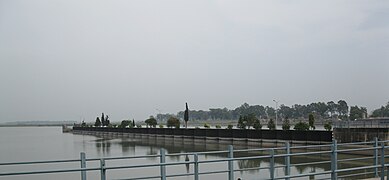Marala Headworks
| Marala Headworks | |
|---|---|
| مرالہ ہیڈ ورکس | |
cusec[1] |
Marala Headworks is a
British India to feed the Upper Chenab Canal, as part of the 'Triple Canals Project'.[2] A new Marala Barrage was constructed in 1968 to feed the Marala–Ravi Link Canal in addition to the original Upper Chenab Canal.[3]
History

The original headworks near Marala along with the Upper Chenab Canal were built as part of the
Triple Canals Project of the British India during 1906–1912.[4] The canal was meant to irrigate an area of 648,000 acres in the Gujranwala District as well as to transfer waters to the Ravi River near Balloki. It was opened in 1912 and fully completed by 1917 at a cost of 37 million PKR.[2] It became profitable in 1938–39.[5]
The waters transferred to the Ravi River were further fed to the
Bahawalpur. The link canal concept initiated in the Triple Canals Project eventually became the basis for the Indus Waters Treaty after the independence of India and Pakistan.[6]
The Marala–Ravi Link Canal was constructed between 1952–1956 in the wake of the Indo-Pakistani water dispute of 1948, when Pakistan became apprehensive of water security on the Ravi and the Sutlej rivers.[4][7] This canal transfers 623 cusecs of water to the Ravi River in order to satisfy the requirements of Balloki and Sulemanki headworks.[4]
Characteristics
Marala Headworks is a large
River Chenab
.
Geography
The Chenab River is a 1,086 kilometres (675 mi) long river which originates from
Marala ravi link canal
and the Upper Chenab Canal. Proposals are under consideration to build Mangla Marala Link Canal to overcome any shortage of water in future.
Marala Headworks is also a picnic spot, a wildlife sanctuary and an unprotected wetland.[citation needed]
- Marala Headworks and picnic area
See also
- List of barrages and headworks in Pakistan
- List of dams and reservoirs in Pakistan
- Punjab Irrigation Department
References
- ^ Report, Dawn (7 September 2014). "Flood peak from Jammu threatens key barrages". Dawn (newspaper). Retrieved 29 November 2020.
- ^ a b c Naqvi, Indus Waters and Social Change (2012), p. 24.
- ^ Singh, Irrigation and Soil Salinity in the Indian Subcontinent (2005), p. 115.
- ^ a b c
Shakir, Abdul Sattar; Khan, Noor M. (2009), "Impact of Structural Interventions on Sediment Management of Large Canals: A Case Study of Marala Barrage, Pakistan", Water Resources Management, 23 (15): 3149–3163, S2CID 153763960
- ^ a b Naqvi, Indus Waters and Social Change (2012), p. 25.
- ^ Chaturvedi, India's Waters: Environment (2011), pp. 203–204.
- ^ Gilmartin, Blood and Water (2020), p 308, note 88.
Bibliography
- Chaturvedi, Mahesh Chandra (2011), India's Waters: Environment, Economy, and Development, CRC Press, ISBN 978-1-4398-7283-3
- Gilmartin, David (2020), Blood and Water: The Indus River Basin in Modern History, Univ of California Press, ISBN 978-0-520-35553-8
- Headrick, Daniel R. (1988), The Tentacles of Progress: Technology Transfer in the Age of Imperialism, 1850-1940, Oxford University Press, ISBN 978-0-19-802178-0
- Naqvi, Saiyid Ali (2012), Indus Waters and Social Change: The Evolution and Transition of Agrarian Society in Pakistan, Oxford University Press Pakistan, ISBN 978-0-19-906396-3
- Singh, N. T. (2005), Irrigation and Soil Salinity in the Indian Subcontinent: Past and Present, Lehigh University Press, ISBN 978-0-934223-78-2



